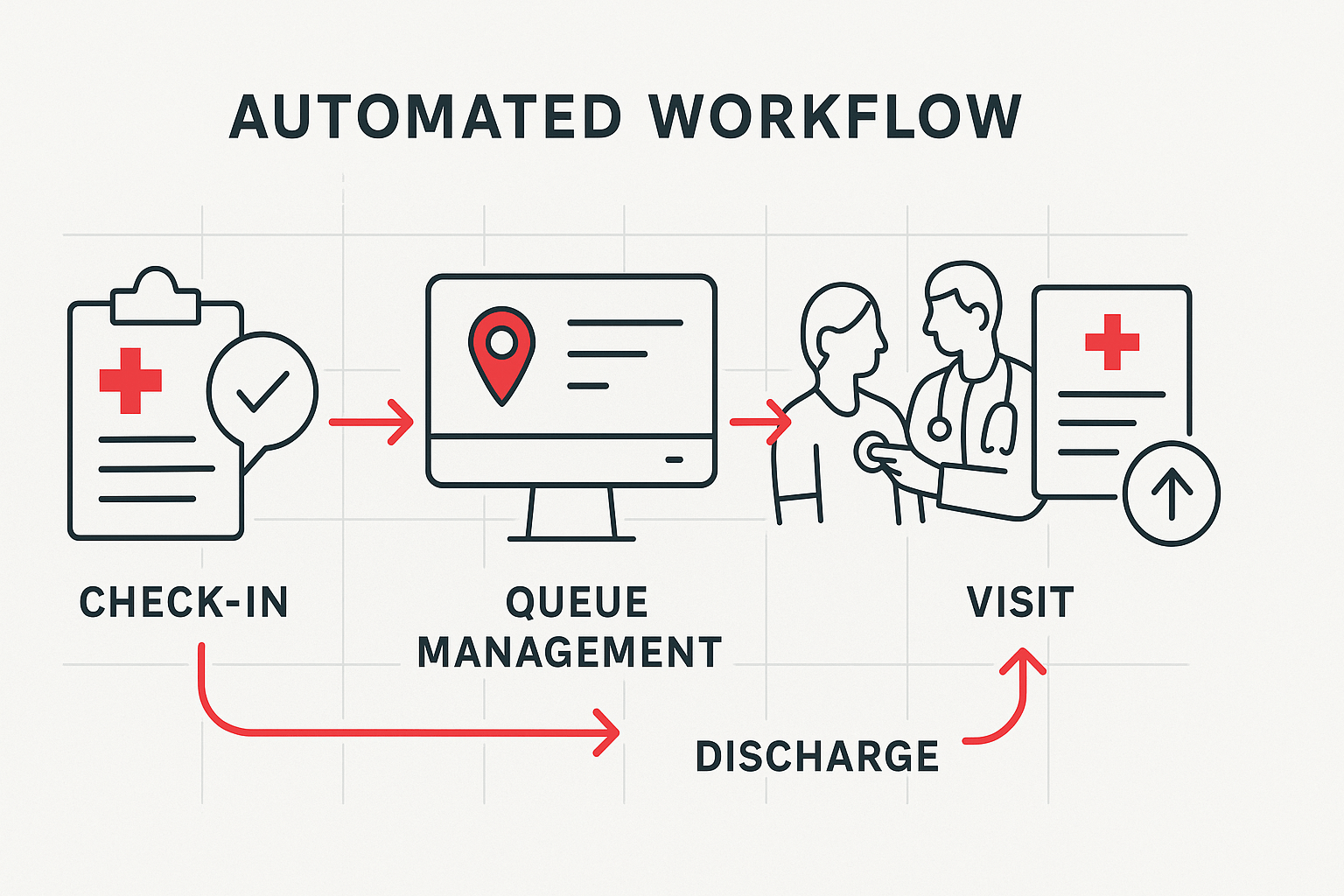How Automation Transforms Urgent Care Clinics: Reduce Wait Times & Boost Patient Satisfaction
by Design Delulu Editorial · September 26, 2025

Urgent care clinics operate in a high-pressure environment where every minute counts. Patient volumes fluctuate unpredictably, administrative tasks pile up, and staff burnout threatens quality care. The right automation strategy doesn't just save time—it transforms how your clinic delivers care, manages resources, and grows revenue. When implemented strategically, automation becomes your competitive advantage in an increasingly crowded healthcare landscape.
The stakes are clear: clinics that embrace intelligent automation see measurable improvements in patient throughput, staff satisfaction, and operational margins. Those that don't risk falling behind competitors who can offer faster service, better experiences, and more efficient care delivery. This isn't about replacing human touch—it's about empowering your team to focus on what matters most while technology handles repetitive, time-consuming processes that drain resources and create bottlenecks.

Why Urgent Care Clinics Need Automation Now
The urgent care landscape has evolved dramatically. Patients expect the convenience of online booking, real-time wait updates, and seamless digital experiences they get everywhere else. Meanwhile, your administrative staff spends hours on manual data entry, appointment confirmations, insurance verification, and follow-up coordination. This creates a frustrating paradox: you're busy but not profitable, overwhelmed but understaffed.
Automation solves this by systematically identifying and eliminating inefficiencies across your entire operation. From the moment a patient searches for your clinic online to their post-visit follow-up, every touchpoint becomes an opportunity to deliver better service with fewer resources. Smart automation tracks which marketing channels drive high-value patients, monitors operational bottlenecks in real-time, and provides actionable insights that help you make data-driven decisions rather than guessing what works.
The financial impact is substantial. Clinics implementing comprehensive automation strategies typically reduce administrative overhead by thirty to forty percent while increasing patient capacity by fifteen to twenty-five percent—without adding staff. Insurance claim processing accelerates, reducing days sales outstanding. Patient no-shows drop significantly through automated reminders and easy rescheduling options. These improvements compound over time, creating sustainable competitive advantages that directly impact your bottom line.
Core Automation Systems That Drive Results
Effective automation for urgent care clinics centers on three critical systems working in harmony: patient engagement automation, operational workflow automation, and data intelligence automation. Each system addresses specific pain points while contributing to overall clinic performance.
Patient engagement automation begins before someone becomes a patient. Your digital presence—website, search listings, social profiles—should capture intent and convert visitors into appointments automatically. This includes intelligent chatbots that answer common questions twenty-four-seven, online scheduling that syncs with your EHR in real-time, and automated pre-registration that collects insurance information before patients arrive. During visits, automated check-in kiosks reduce front-desk congestion while digital intake forms eliminate clipboard chaos and ensure accurate data capture.
Operational workflow automation tackles the behind-the-scenes processes that consume staff time without adding value. Automated insurance verification happens in the background before appointments, flagging issues early rather than during check-in. Smart routing systems direct patients to appropriate providers based on chief complaints and wait times. Prescription management integrates with pharmacy systems, eliminating phone tag and reducing errors. Lab order tracking provides automatic status updates to patients and providers. Billing processes trigger automatically based on documented procedures, accelerating revenue cycle management.
Data intelligence automation transforms raw information into strategic insights. Every patient interaction, every marketing dollar spent, every operational decision generates data. Without automation, this data sits unused in disconnected systems. Intelligent automation creates unified dashboards showing real-time performance across all metrics that matter—patient volume by hour, average wait times, staff utilization, marketing ROI, revenue per patient, payer mix trends, and patient satisfaction scores. These insights enable proactive management rather than reactive firefighting.
Implementation Strategy: From Planning to Performance
Successful automation implementation follows a structured methodology that balances ambition with practicality. The process begins with comprehensive discovery to understand your current state, identify highest-impact opportunities, and establish clear success metrics aligned with business objectives. This phase involves stakeholder interviews, process mapping, data audits, and competitive analysis to create a detailed automation roadmap prioritized by potential impact and implementation complexity.
The blueprint phase translates strategic goals into technical specifications. This includes selecting appropriate automation platforms, designing system architecture, planning data flows, establishing governance frameworks, and creating detailed measurement plans. For urgent care clinics, special attention goes to HIPAA compliance, EHR integration requirements, patient experience considerations, and staff training needs. The blueprint serves as both implementation guide and accountability framework, ensuring all stakeholders understand scope, timelines, and expected outcomes.
Build and launch phase brings the blueprint to life through systematic implementation. This involves configuring automation platforms, integrating systems, building custom workflows, implementing tracking mechanisms, conducting thorough quality assurance testing, and training staff on new processes. Successful launches happen incrementally rather than all at once—starting with highest-impact, lowest-risk automation opportunities and expanding systematically. This approach minimizes disruption while building organizational confidence and demonstrating quick wins.
The optimization phase is where automation delivers compounding returns. With systems live and data flowing, continuous improvement becomes possible. Weekly performance reviews identify what's working and what needs adjustment. A-B testing refines patient communications, scheduling flows, and conversion paths. Attribution analysis reveals which marketing investments drive profitable patient acquisition. Quarterly strategic reviews assess broader trends, adjust priorities, and set new targets. This iterative approach ensures automation evolves with your clinic rather than becoming static infrastructure.

Deliverables
- Comprehensive tracking plan documenting all patient touchpoints and conversion events
- GA4 and server-side tag management configuration for accurate, privacy-compliant measurement
- Custom dashboards providing real-time visibility into clinical and business performance
- Attribution model settings that accurately credit marketing channels driving patient acquisition
- Automation workflow documentation and staff training materials
- Integration specifications for EHR, scheduling, billing, and communication systems
Measuring Success: KPIs That Matter for Urgent Care
Automation success demands clear measurement tied to business outcomes. For urgent care clinics, this means tracking metrics across four categories: patient acquisition, operational efficiency, financial performance, and patient satisfaction. Each category contains leading and lagging indicators that together paint a complete picture of clinic health.
Patient acquisition metrics track how effectively you attract and convert potential patients. These include organic search visibility for local intent queries, website conversion rates from visitor to scheduled appointment, cost per acquisition across paid channels, patient lifetime value by acquisition source, and new patient volume trends. Automation improves these metrics by optimizing digital touchpoints, personalizing patient communications, and providing attribution clarity that guides marketing investment decisions.
Operational efficiency metrics reveal how well your clinic functions internally. Key indicators include average wait time from check-in to provider, patient throughput per provider per shift, staff utilization rates, no-show and cancellation rates, check-in to discharge cycle time, and administrative time per patient encounter. Effective automation dramatically improves these metrics by eliminating manual handoffs, reducing data entry burden, optimizing scheduling, and streamlining workflows.
Financial performance metrics connect operations to revenue. Critical measures include revenue per patient visit, collection rates by payer type, days in accounts receivable, cost per patient encounter, profit margin by service line, and year-over-year revenue growth. Automation accelerates revenue cycle management, improves coding accuracy, reduces claim denials, and provides visibility into profitability drivers that inform strategic decisions.
Patient satisfaction metrics indicate whether automation enhances or hinders patient experience. Track net promoter scores, online review ratings and volume, patient survey responses, return visit rates, and referral rates. Well-designed automation increases satisfaction by reducing wait times, improving communication, eliminating administrative friction, and allowing staff to focus on personal interaction rather than paperwork.
Best Practices
- Prioritize highest-impact automation opportunities first—start with processes that are high-volume, time-consuming, and error-prone to demonstrate quick wins and build organizational momentum.
- Pair every automation initiative with clear measurement—establish baseline metrics before implementation and track improvement consistently to prove ROI and guide optimization.
- Use templates and standardized workflows to scale quickly—create reusable automation patterns for common scenarios rather than building custom solutions for every situation.
- Maintain human oversight and intervention capabilities—automation should assist staff decision-making, not replace judgment, especially for complex clinical or patient experience situations.
- Close the loop with regular performance reviews—schedule weekly tactical reviews to address immediate issues and quarterly strategic sessions to adjust priorities based on results.
- Design automation with patient experience as primary consideration—technology should make interactions easier and more personal, never create barriers or frustration.
- Ensure robust data governance and security protocols—healthcare automation requires strict HIPAA compliance, access controls, audit trails, and disaster recovery planning.
- Invest in comprehensive staff training and change management—automation succeeds or fails based on user adoption, requiring clear communication, training, and ongoing support.
Industry-Specific Tips for Urgent Care Clinics
- Map search intent to urgent care patient journey stages—people searching 'urgent care near me' have different needs than those researching specific conditions or comparing clinic options.
- Automate the appointment confirmation and reminder sequence—reduce no-shows with multi-channel reminders via text, email, and voice at optimal intervals before scheduled visits.
- Use social proof and outcomes early in the patient journey—showcase average wait times, patient testimonials, and provider credentials on high-traffic pages to build trust quickly.
- Implement real-time wait time displays—publish current wait times on your website and Google Business Profile to set expectations and attract patients during slow periods.
- Create automated post-visit follow-up sequences—check patient recovery, request reviews, encourage return visits, and capture feedback while experience is fresh.
- Measure against a single source of truth dashboard—consolidate data from all systems into unified reporting that everyone references for consistency in decision-making.
- Automate insurance eligibility verification before appointments—catch coverage issues early, reducing denied claims and awkward conversations at check-in.
- Build specialty-specific intake automation—customize digital intake forms based on chief complaint to gather relevant history efficiently and route appropriately.
- Ship small improvements continuously—implement automation incrementally, test results quickly, and compound small wins rather than waiting for perfect comprehensive solutions.
- Leverage automation for staff communication—use automated alerts for unusual wait time spikes, supply shortages, schedule changes, or urgent operational issues requiring immediate attention.

Frequently Asked Questions
Let’s level up your Urgent Care Clinics business
Need services that actually move the needle for Urgent Care Clinics? See our approach, pricing, and timelines—then book a quick call.
Additional Resources
- Schedule Your Automation Strategy Call
Book a complimentary thirty-minute consultation to discuss your urgent care clinic's specific automation needs, challenges, and opportunities. We'll assess your current state, identify quick wins, and outline a customized roadmap with estimated timelines and ROI projections tailored to your operation.
- View Our Urgent Care Automation Portfolio
Explore real-world automation case studies and results from urgent care clinics we've helped transform. See before-and-after metrics, implementation timelines, and the specific automation workflows that drove measurable improvements in patient throughput, staff efficiency, and revenue growth.
- Access Free Automation Tools & Resources
Download free templates, calculators, and planning tools designed specifically for urgent care automation. Resources include ROI calculators, workflow mapping templates, KPI tracking spreadsheets, and implementation checklists you can use immediately to begin your automation journey.
Related Reading

Discover how automation for electricians streamlines scheduling, invoicing, lead tracking, and customer follow-ups to boost revenue and efficiency. Get started today.

Discover how automation streamlines furniture & home decor operations with GA4 tracking, attribution modeling, and data-driven dashboards. Get your 90-day implementation roadmap.
